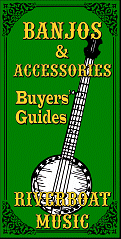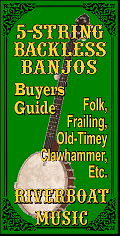Acoustic Instrument
Primers
What Kind of Guitar
Should I Start On?
What Kind of Banjo
Do I Want?
Evaluating and
Buying Used
Guitars
Setting Up
Fretted Instruments Whatever Happened
to the Banjo?
Beginning Five-
String Banjo
6-String Banjos
Banjo Pickups
Axes in my Life
What is a
Bluegrass Banjo?
Dean "Backwoods
Six" Shootout
Music Theory
Primers
Introduction
to Scales
Introduction
to Chords
Circle of Fifths
Other Articles
About Music
How to Give
Guitar Lessons
Musician or
Wannabe? Did God Really
Give Rock &
Roll to You?
Are You a
"Brand Bigot"?
Who Owns Folk Songs?
Historical Links
About the
National Road
The Story Behind
the Story - Real
People, Places,
and Events
About the Play
Play Home
What's New
Overview
About the
Music
About the
History
About the
Logistics
About the
Cast
Synopsis
About the
Set
About the
Author
Contact Us
Home



|

|

"Buffalo Gals" for 5-String Banjo Songs from Creek Don't Rise(tm)
| Written by Paul Race for Creek Don't RiseTM and School Of The RockTM |
We use a G-tuning version of the verse in lesson 2 of our free online 5-string Banjo Tutorial. In those materials, we show only an accompaniment part, because the melody is a little too syncopated for beginning pickers. In fact, the line "Come out Tonight," as commonplace as it seems today, shows an unusual grasp of simple West African rhythms for its time, something totally unknown among the western European peoples who settled the Northeast. Long after the minstrel shows disappeared, the song made its way throughout the country's dance halls, and eventually into a number of movie and television shows.
Buffalo Gals in C
The chorus of this song is hard to sing in the key of G, so we're presenting the entire song in the key of C for this page, including the chorus.
To play this song, your fourth string needs to be tuned down to a C, a step lower than the G tuning most modern banjo players are used to. This is actually "standard" tuning, and was used more often than any other banjo tuning until about 1967. Nowadays folks call it "C" tuning. The chords you will use are shown in the following table:
 |
 |
For more about Standard ("C") tuning, check out Lesson 9 of our beginning 5-string banjo tutorial.
Click this icon to hear our simple accompaniment played with the melody. 
Click the little icon to the right to hear this accompaniment played without the melody. 
To see printable sheet music, click on the staff below.

More Lyrics - We also have a printer-friendly lyric sheet you can print out as a handout. Click here to see it.
Playing Solo - There are probably as many ways to play this solo as there are banjo players. Here's one way that builds on the principles shown above and in earlier lessons. The third note can be picked or can be slid up to, depending on your preference. If you're going to slide, you first pick the fourth string unfretted, then hammer viciously on the second fret and slide the same finger up to the fourth fret, trying to keep the string ringing. If this doesn't work for you, and you have the right-hand dexterity to pick the E on the fourth fret of the fourth string, you may certainly do that instead. I'm sure many folks would prefer that.
When the song goes to F, we chose a simple accompaniment you can do just by fretting the third string right next to where you're fretting the fourth string. Some pickers play up there all the time, but I don't, so I get you back down to root position on the next measure.
Note: If you don't "get" this solo, or never "nail it," that doesn't mean you should hang your head in shame - this takes a tad more practice than a lot of solos in G. The main thing is to try and figure out the basic principles of the thing. If nothing else, you should never have to "drop out" entirely when someone in a band or jam session proposes playing a song in the key of C again.
Click this icon to hear it played. 
To see printable sheet music, click on the staff below.

Buffalo Gals in G
Our free online 5-String Banjo Tutorial starts with a simple, strummed version of "Buffalo Gals" and works its way up to a traditional picked accompaniment, all in the key of G. So if you really want to learn this song and you don't play banjo at all, that might be a good place to start. That said, we didn't include the whole song, because parts of it are pretty tough for most people to sing in G.In case you want to stay in G, we've expanded the accompaniment version to include the whole song.
- Sheet Music of Accompaniment in G.
- Mp3 of Accompaniment with melody in G
- Mp3 of Accompaniment with just banjo in G
We've also added a solo version in G for folks who are more comfortable playing in that key. Just don't ask normal people to sing along with you when you play it in G.
For one part that needs a D to C note in a hurry, you might try fretting the second string on the first and third fret at the same time. Then you play the D by picking the string, and you play the C by pulling off the third fret, letting the note on the first fret ring. If you prefer, you can play that sequence simply by playing the D open on the first string, then rapidly picking the C on the first fret of the second string. Again, no banjo solo ever written or played has one single right way to play it, and I'm just suggesting techniques similar to those I've shown in our 5-String Banjo Tutorials.
Note About Blues Licks - If you're committed to playing this song in G, you also have the opportunity to "Bluegrass" it up a little by adding some "blues licks" on the B notes that hit on the first or third beat of the measures.
Some tips on doing this are shown in Lesson Four of our tutorial.
Conclusion
As simple as this song is, it's one of the most recognized songs in American culture. I also confess to having an "early childhood memory" of singing this song. We had a "dancing doll," which was more or less a big rag doll with elastic straps on her feet. You'd slide them over your feet, and pretend you were dancing with it. No, I was not a huge fan of dance as a three-year old, but I remember her because we used to sing the verse "I danced with a dolly with a hole in her stocking." And it was only when I was researching this song some 59 years later, that I realized we'd been singing the "wrong" words all this time.Since the dance halls faded, the song has made many "cameo appearances" in movies and television, including It's a Wonderful Life and the Thirty-Something logo splash. I would not be surprised if you couldn't get a lot of folks to sing along in a public performance anywhere in the United States or Canada.
Whatever else you get out of your experience with this song, I hope you enjoy your music and figure out how to make enjoyable music for those around you as well.
And please stay in touch!
Click here to return to the Banjo Songs page.
All material, illustrations, and content of this web site is copyrighted ? 2001, 2002, 2003, 2004, 2005, 2006,
2007, 2008, 2009, 2010, 2011, 2012, 2013, 2014, 2015 by Paul D. Race. All rights reserved.
Creek Dont' Rise(tm) is a participant in the Amazon Services LLC Associates Program, an affiliate advertising
program designed to provide a means for sites to earn advertising fees by advertising and linking to Amazon.com.
For questions, comments, suggestions, trouble reports, etc. about this page or this site, please contact us.
| Visit related pages and affiliated sites: | |||||
| - Music - | |||||

|
 |
 |

|

|

|

|

|

|

|

|

|

|

|

|

|

|

|
| - Trains and Hobbies - | |||||
 |

|

|  |
 |

|
| - Christmas Memories and Collectibles - | |||||
 |

|
 |

|
 |

|
| - Family Activities and Crafts - | |||||
 |

|

|

|

|

|

